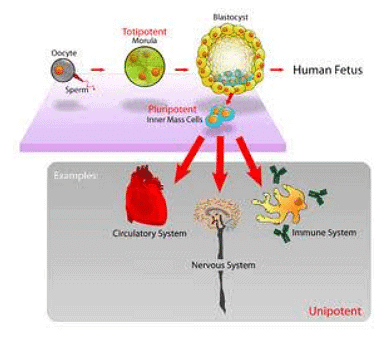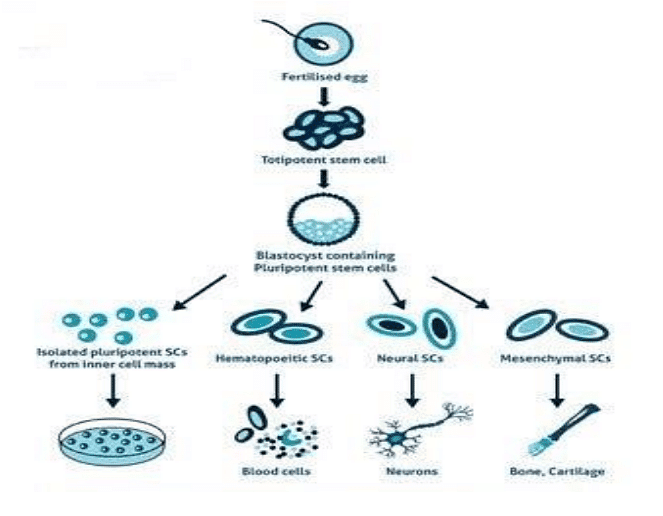Stem Cells | Zoology Optional Notes for UPSC PDF Download
What are Stem Cells?
Stem cells are undifferentiated cells present in the human body, capable of giving rise to various specialized cells through a process known as differentiation. Under controlled experimental settings, these stem cells have the ability to undergo division, producing daughter cells. These daughter cells may either retain their stem cell characteristics through self-renewal or differentiate into functional cells, such as blood cells or brain cells.
Where do these stem cells come from?
Researchers have identified various reservoirs of stem cells, including:
- Embryonic stem cells: Derived from 3 to 5-day-old embryos, these cells are highly versatile and can be employed for both regenerative and cell replacement purposes.
- Adult stem cells: Present in small quantities in most adult tissues like bone marrow or fat, these cells have a more limited capacity compared to embryonic stem cells but still exhibit versatility, although not to the same extent.
- Adult cells modified to possess embryonic stem cell properties: Scientists have successfully reprogrammed regular adult cells into stem cells using genetic manipulation. By altering the genes in adult cells, researchers can induce them to function similarly to embryonic stem cells.
- Perinatal stem cells: Stem cells have been identified in amniotic fluid and umbilical cord blood, possessing the ability to differentiate into specialized cells when needed.
Embryonic Stem Cells (ESCs)
ESCs, or embryonic stem cells, are pluripotent cells obtained from the inner cell mass of a blastocyst, an early-stage embryo before implantation. The blastocyst, typically formed 4-5 days after fertilization in human embryos, comprises 50-150 cells. The ethical concerns arise from the fact that isolating the embryoblast or inner cell mass (ICM) leads to the destruction of the blastocyst. This process prompts debates on ethical grounds, questioning whether embryos at the pre-implantation stage should be accorded the same moral considerations as embryos in the post-implantation stage of development.
Properties
Embryonic stem cells (ESCs) are obtained from the blastocyst stage of early mammalian embryos and are characterized by their unique ability to differentiate into any type of embryonic cell and undergo self-renewal. These distinctive features make them highly valuable in scientific and medical research. ESCs exhibit a normal karyotype, maintain high telomerase activity, and possess remarkable long-term proliferative potential.
- Pluripotent Characteristics: ESCs, originating from the inner cell mass, are pluripotent, meaning they can differentiate into primitive ectoderm, which later gives rise to all three primary germ layers—ectoderm, endoderm, and mesoderm. This capacity allows them to generate more than 220 cell types found in the adult human body. The appropriate signals induce ESCs to form precursor cells that subsequently differentiate into specific cell types, distinguishing them from multipotent adult stem cells that produce a limited range of cell types.
- Self-Renewal and Structural Repair: Under specific conditions, ESCs can self-renew indefinitely while maintaining an undifferentiated state. The conditions for self-renewal must prevent cell clumping and provide an environment conducive to an unspecialized state. This is typically achieved using media containing serum and leukemia inhibitory factor or serum-free media supplemented with two inhibitory drugs ("2i"), including the MEK inhibitor PD03259010 and GSK-3 inhibitor CHIR99021.
- Growth Characteristics: ESCs undergo frequent cell division due to a shortened G1 phase in their cell cycle. Rapid cell division enables them to quickly increase in number, a crucial aspect of early embryo development. ESCs express high levels of cyclin A and cyclin E proteins involved in the G1/S transition, and the CDK2 proteins that promote cell cycle progression are overactive. Hyperphosphorylation and inactivation of retinoblastoma (Rb) proteins, which inhibit the transcription factor E2F, contribute to continual expression of proliferation genes in ESCs.
These changes result in accelerated cell division cycles. While the shortened G1 phase is associated with pluripotency maintenance, ESCs grown in serum-free 2i conditions express hypo-phosphorylated active Rb proteins and have an elongated G1 phase. Pluripotency factors Oct4 and Nanog play a role in transcriptionally regulating the ESC cell cycle.

Uses
Due to their flexibility and potentially limitless self-renewal capacity, embryonic stem cells (ESCs) have been proposed for applications in regenerative medicine and tissue replacement following injury or disease. Pluripotent stem cells, such as ESCs, show promise in treating various conditions, including spinal cord injuries, age-related macular degeneration, diabetes, neurodegenerative disorders (such as Parkinson's disease), and AIDS, among others. Additionally, ESCs offer an alternative source for tissues and organs. They play a crucial role in research on early human development, certain genetic diseases, and in vitro toxicology testing.
Clinical Applications:
- Cell Replacement Therapies (CRTs):
- Differentiated cell types emerging from ESCs include cardiomyocytes, neurons, hepatocytes, bone marrow cells, islet cells, and endothelial cells, with ongoing research in these areas.
- ESCs have been differentiated into natural killer (NK) cells and bone tissue, and efforts are underway to utilize them in treating conditions like Parkinson's disease and diabetes.
- Drug Discovery:
- ESCs serve as an alternative to organ transplants and are employed in toxicology studies and cellular screens for identifying new chemical entities (NCEs) suitable for developing small molecule drugs.
- Cardiomyocytes derived from ESCs are validated in vitro models for testing drug responses and predicting toxicity profiles. ESC-derived hepatocytes also contribute to preclinical stages of drug discovery.
- Genetic Disorder Modeling:
- ESCs are used to model genetic disorders by genetic manipulation or by deriving diseased cell lines identified through prenatal genetic diagnosis (PGD). This approach is valuable for studying disorders like Fragile-X syndrome and Cystic fibrosis.
- DNA Damage Repair:
- ESCs and differentiated somatic cells employ different strategies for dealing with DNA damage. ESCs predominantly use high-fidelity homologous recombinational repair (HRR) to accurately repair double-strand breaks (DSBs) and undergo apoptosis as a fail-safe strategy to eliminate cells with unrepaired DNA damages.
- Clinical Trials:
- ESC-based therapies have entered Phase I clinical trials, such as the transplantation of oligodendrocytes derived from human ESCs into individuals with spinal cord injuries. These trials aim to assess safety and potential benefits, marking significant progress in stem cell research.
- These diverse applications underscore the immense potential of ESCs in advancing medical treatments, understanding genetic disorders, and contributing to drug development.
Concern and controversy
- Adverse Effects: The primary concern associated with the potential transplantation of Embryonic Stem Cells (ESCs) as therapies is their propensity to form tumors, including teratomas. This safety concern led the FDA to impose a hold on the initial ESC clinical trial; however, no tumors were observed. To address safety issues, a key strategy involves differentiating ESCs into specific cell types, such as neurons, muscle cells, or liver cells, which have a reduced or eliminated ability to cause tumors. Following differentiation, cells undergo sorting by flow cytometry for further purification. ESCs are considered to be inherently safer than induced Pluripotent Stem (iPS) cells created with genetically-integrating viral vectors because ESCs are not genetically modified with genes, such as c-Myc, associated with cancer. Although ESCs express high levels of iPS-inducing genes essential for self-renewal and pluripotency, efforts are underway to improve safety by eliminating the expression of genes like c-Myc. Recent protocols for inducing pluripotency bypass these concerns by using nonintegrating RNA viral vectors like Sendai virus or mRNA transfection.
- Ethical Debate: The ethical implications surrounding the use of embryonic stem cells arise from the necessity to destroy the embryo during the harvesting process. The moral status of the embryo becomes a subject of debate, with some arguing that a 5-day-old mass of cells is too young to attain personhood or that embryos donated from in vitro fertilization (IVF) clinics, where labs typically acquire them, would otherwise be discarded as medical waste. Opponents of ESC research contend that an embryo constitutes human life, and destroying it is considered morally equivalent to murder, advocating for the protection of embryos under the same ethical considerations as more developed human beings.
|
198 videos|351 docs
|
FAQs on Stem Cells - Zoology Optional Notes for UPSC
| 1. What are stem cells? |  |
| 2. Where do stem cells come from? |  |
| 3. What are embryonic stem cells (ESCs)? |  |
| 4. How are stem cells used in research and medicine? |  |
| 5. Are there any ethical concerns associated with stem cell research? |  |
















